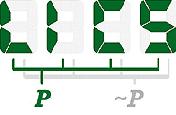Paper: Constructive negation for constraint logic programming (at LICS 1991)
Authors: Peter J. StuckeyAbstract
Constructive negation is an extension of the negation as failure rule to handle nonground negative subgoals in a constructive manner. It entails the following procedure: nodes of the subderivation for the nonground negative subgoal are collected as a disjunction and negated giving a formula equivalent to the negative subgoal. Constructive negation was formulated for logic programming in the Herbrand universe by introducing disequality constraints. A framework for constructive negation for constraint logic programming over arbitrary structures that is sound and complete with respect to the three-valued consequences of the completion of a program is described, and a simpler, more efficient form of constructive negation for the Herbrand universe is obtained. What makes a structure particularly suited to the use of constructive negation is characterized, and this suitability condition is shown for a number of structures and classes of structures
BibTeX
@InProceedings{Stuckey-Constructivenegatio,
author = {Peter J. Stuckey},
title = {Constructive negation for constraint logic programming},
booktitle = {Proceedings of the Sixth Annual IEEE Symp. on Logic in Computer Science, {LICS} 1991},
year = 1991,
editor = {Giles Kahn},
month = {July},
pages = {328--339},
location = {Amsterdam, The Netherlands},
publisher = {IEEE Computer Society Press}
}
